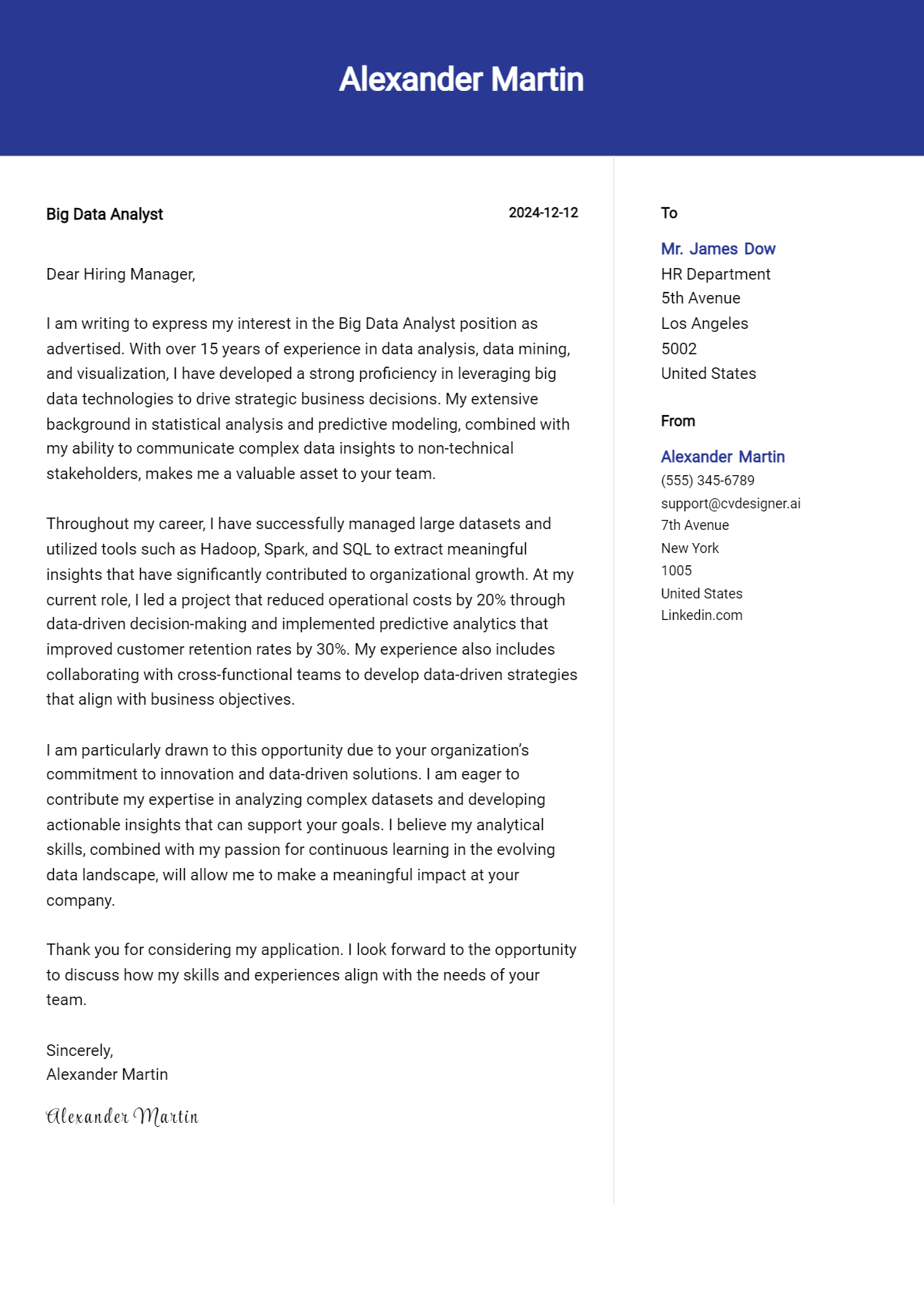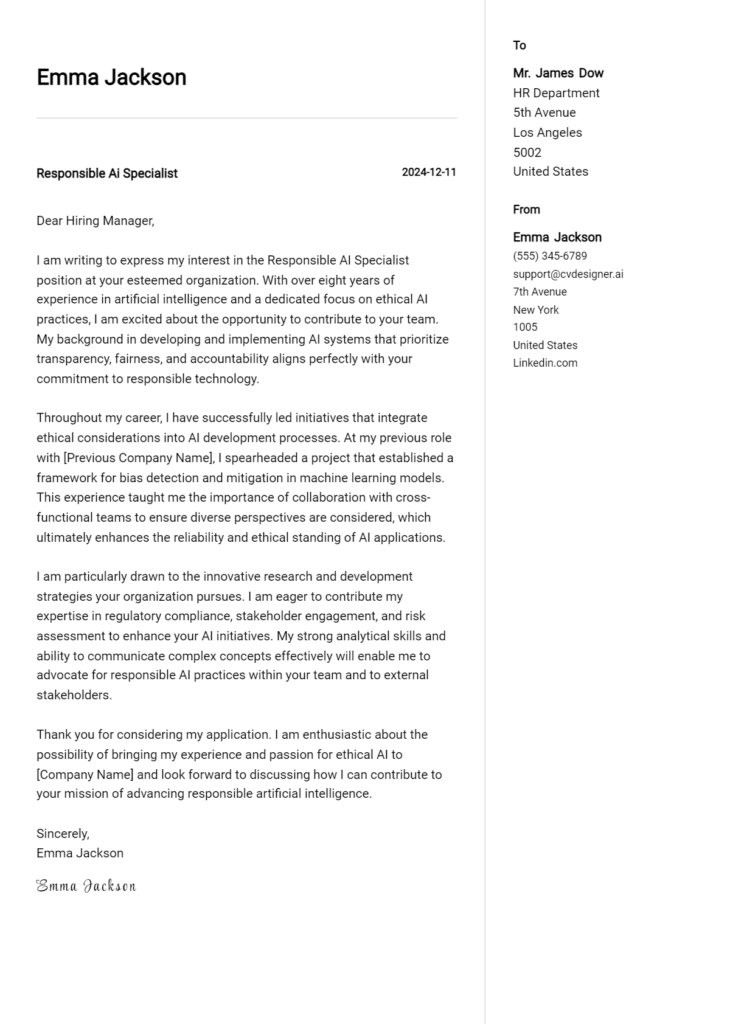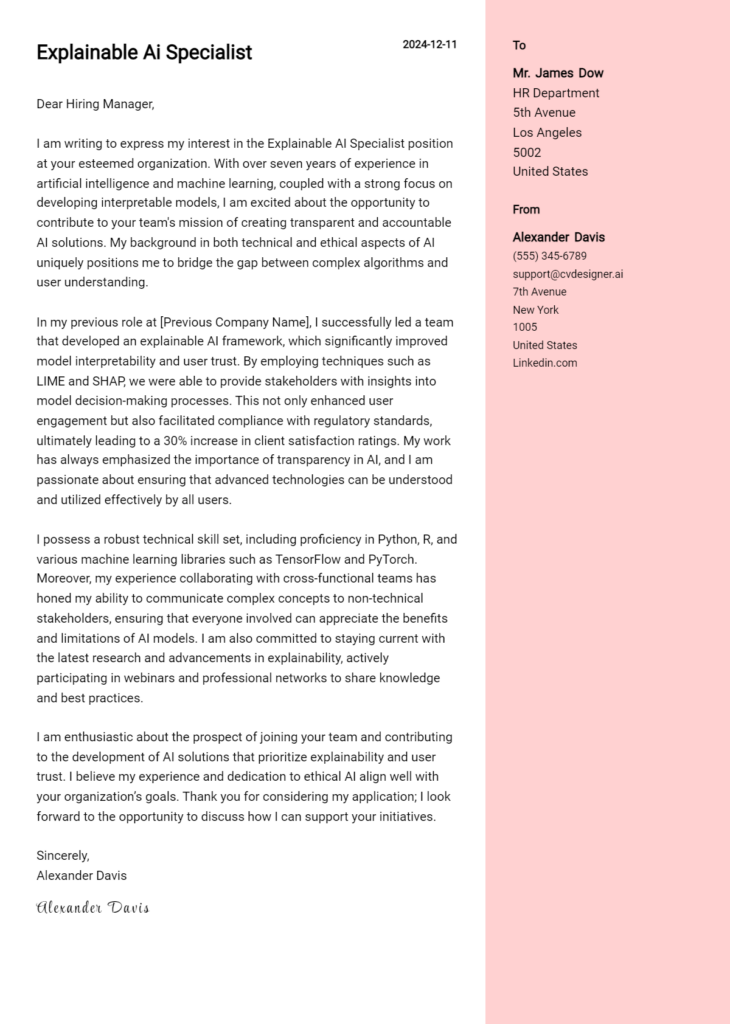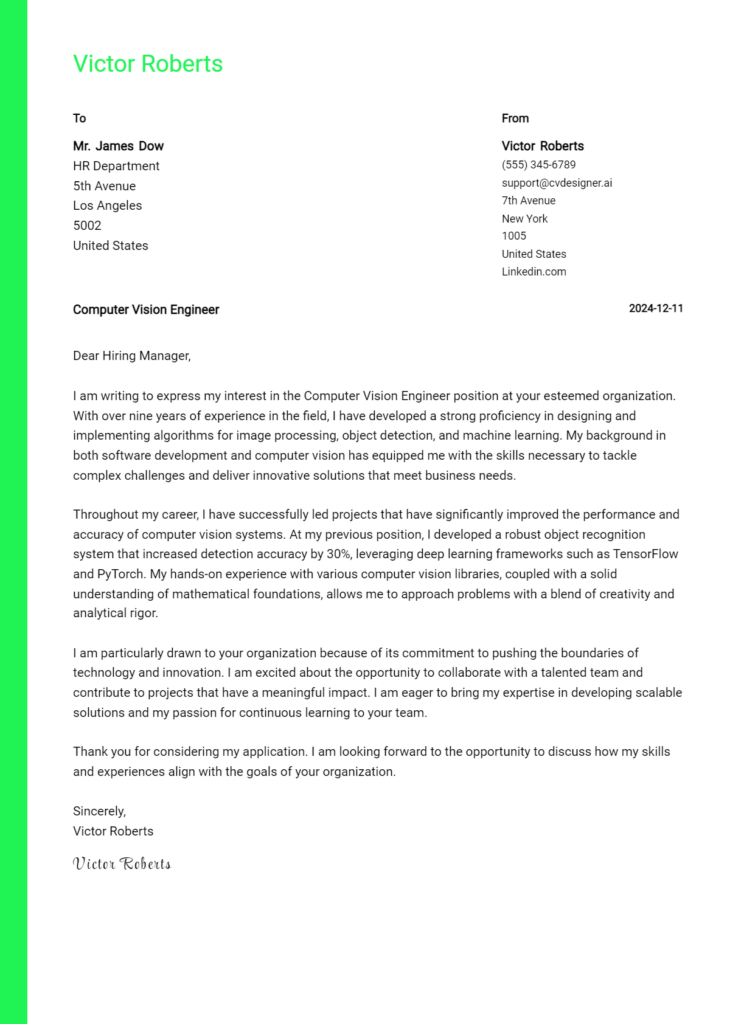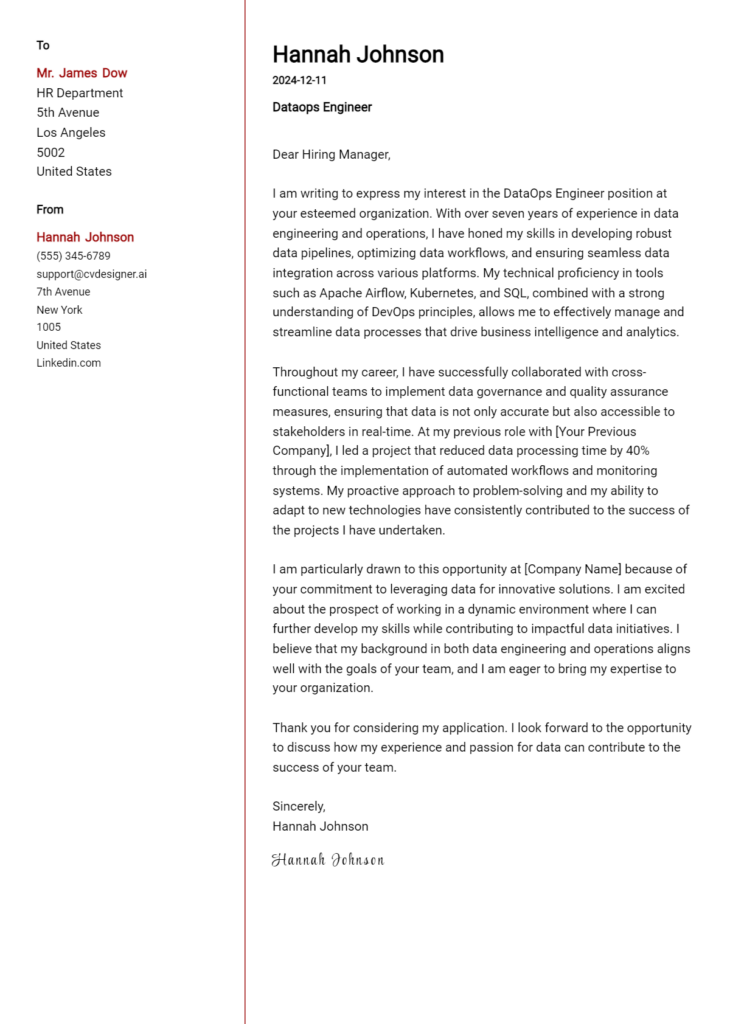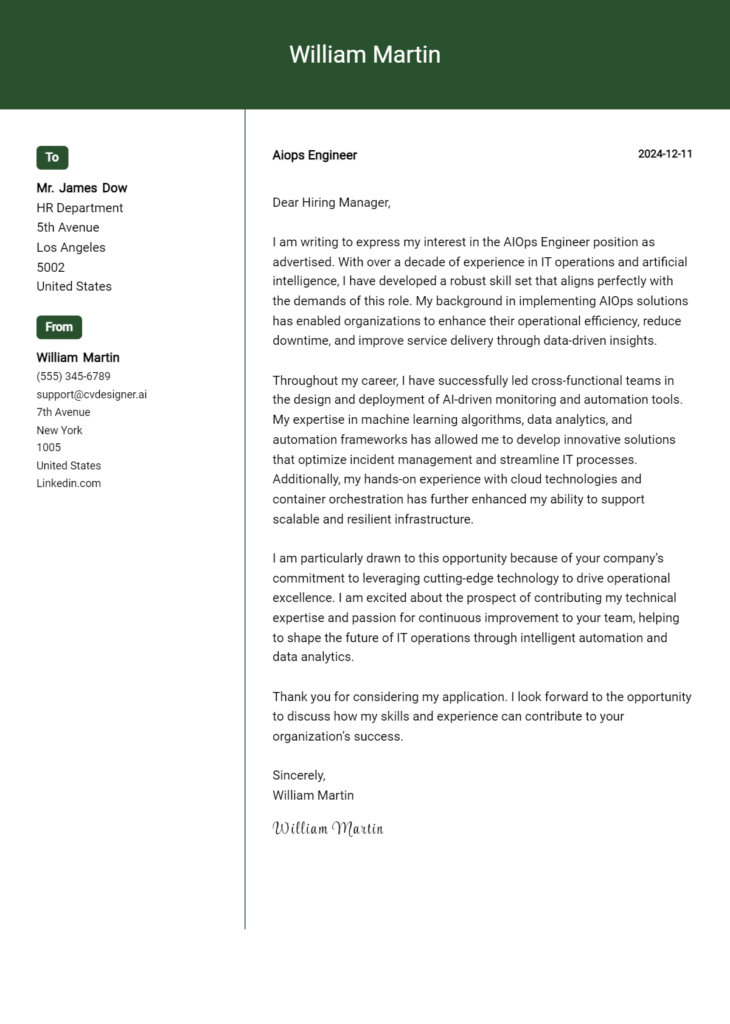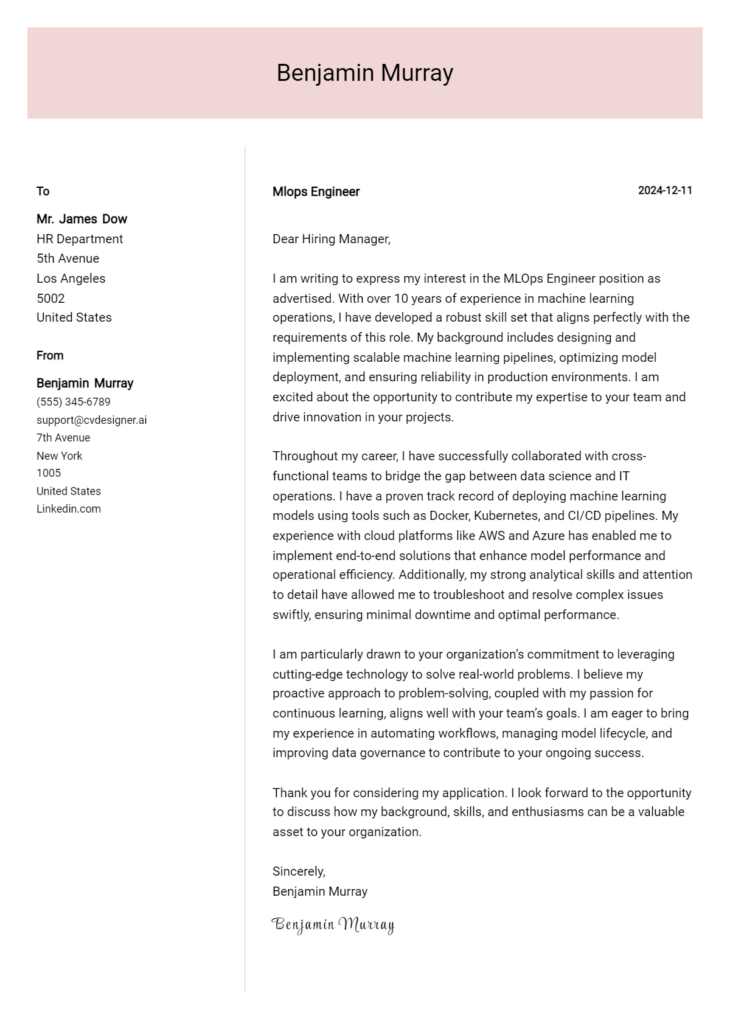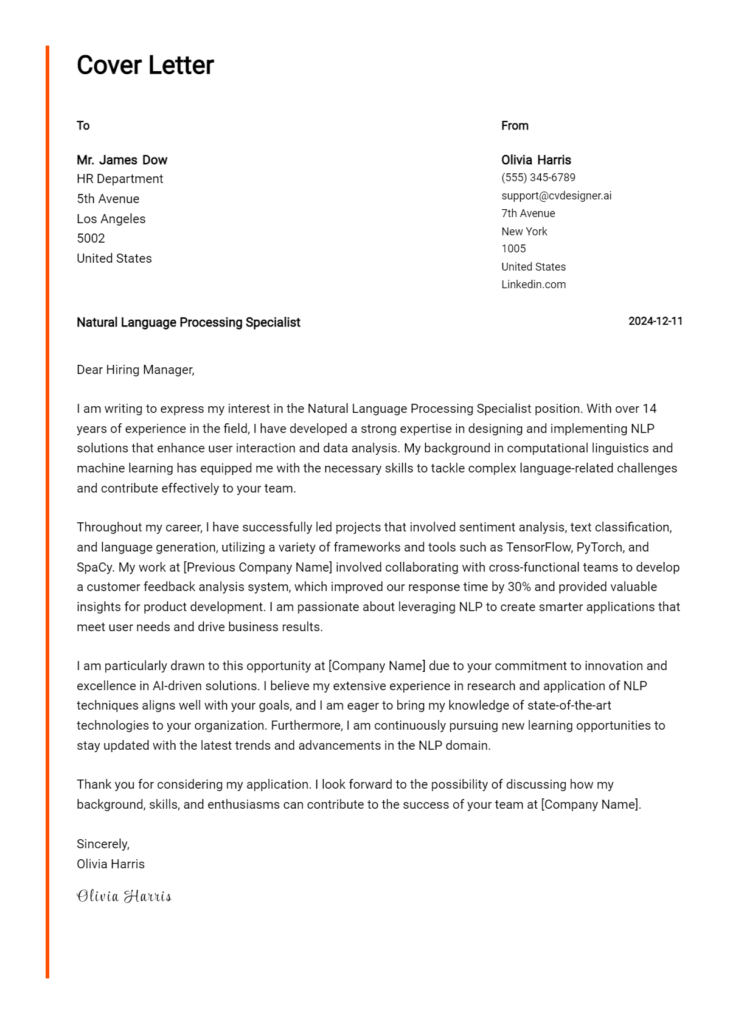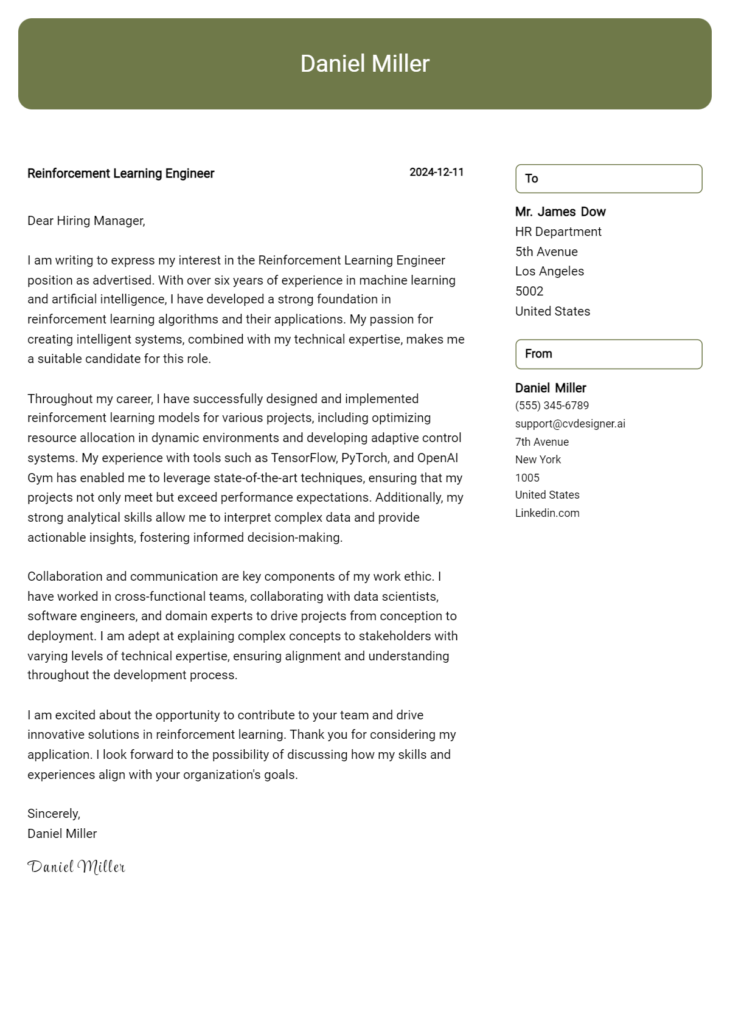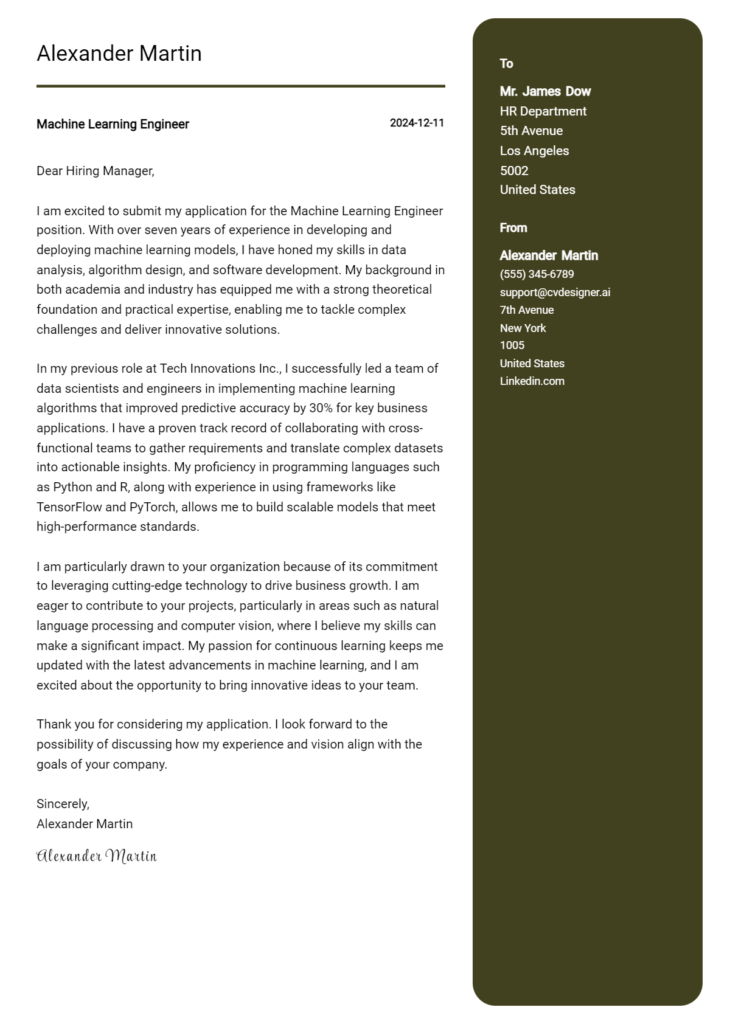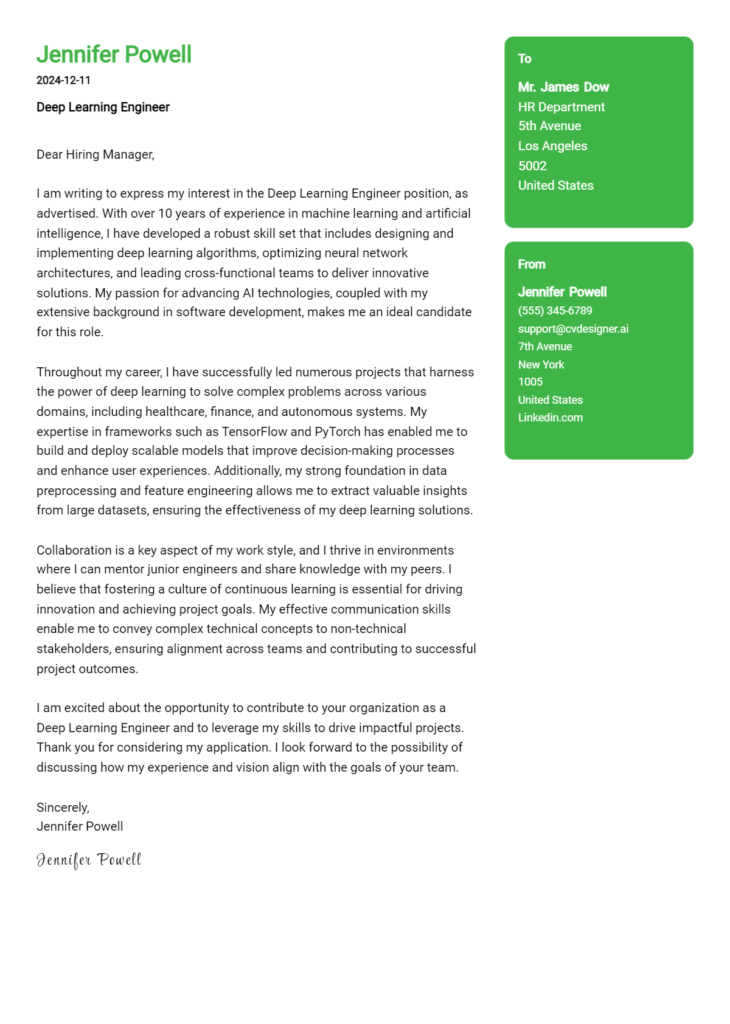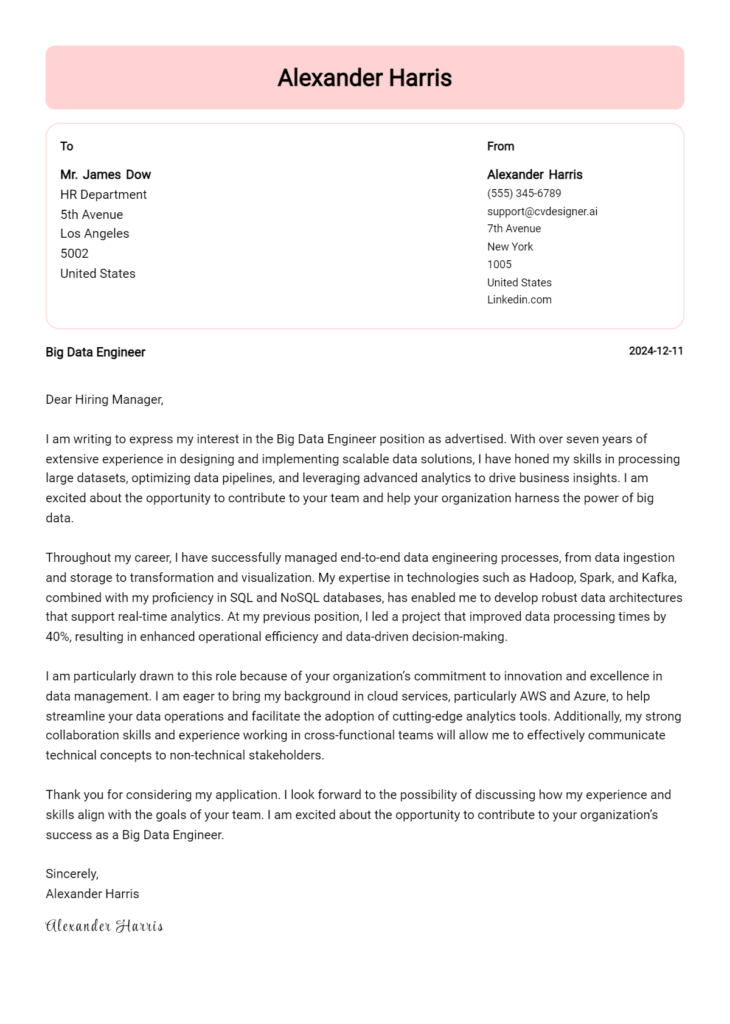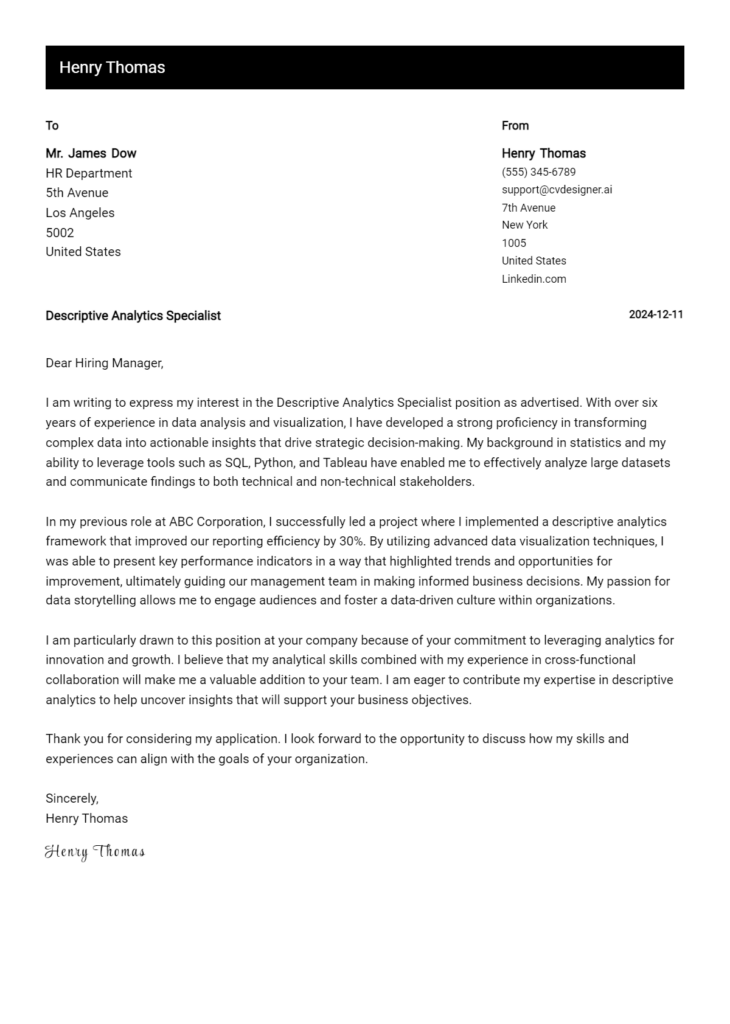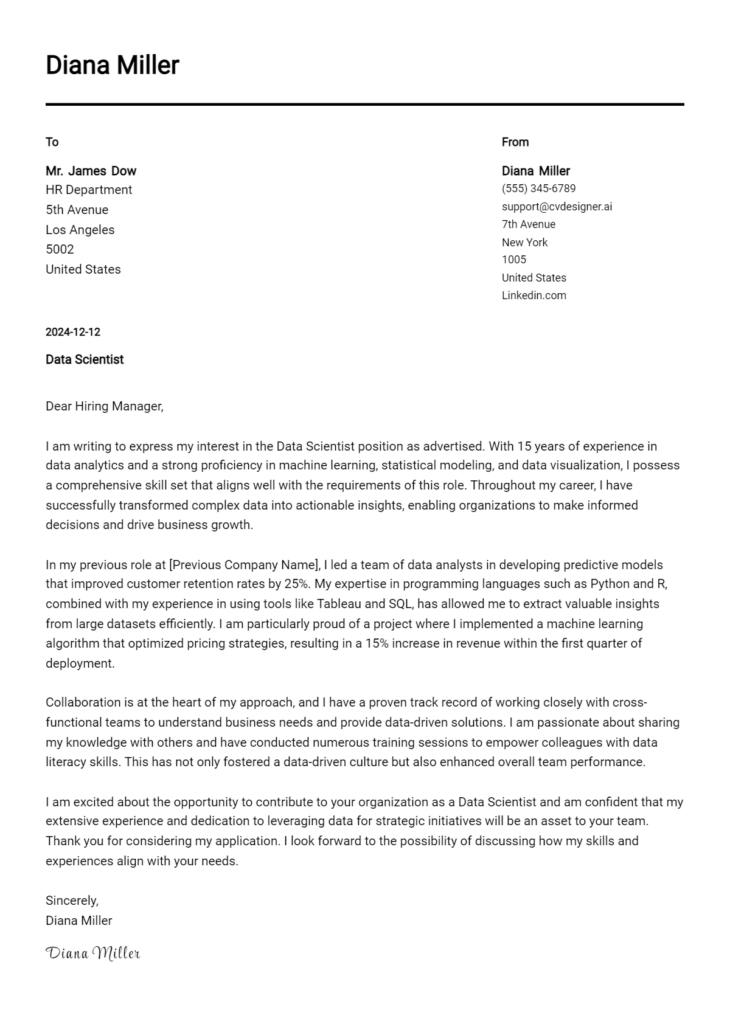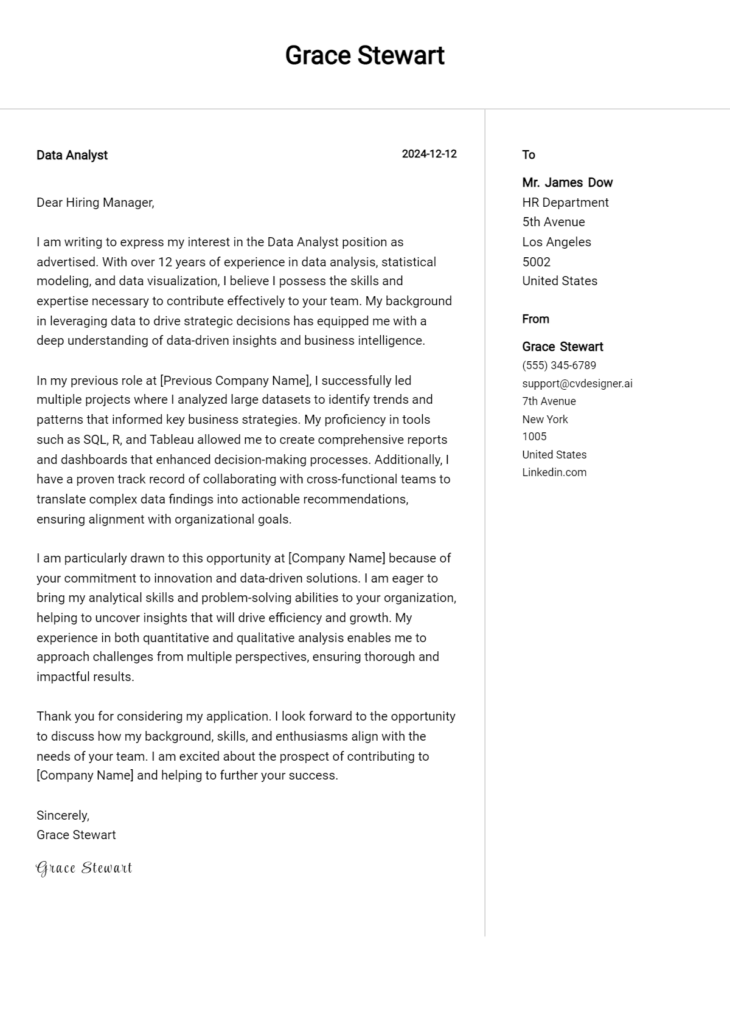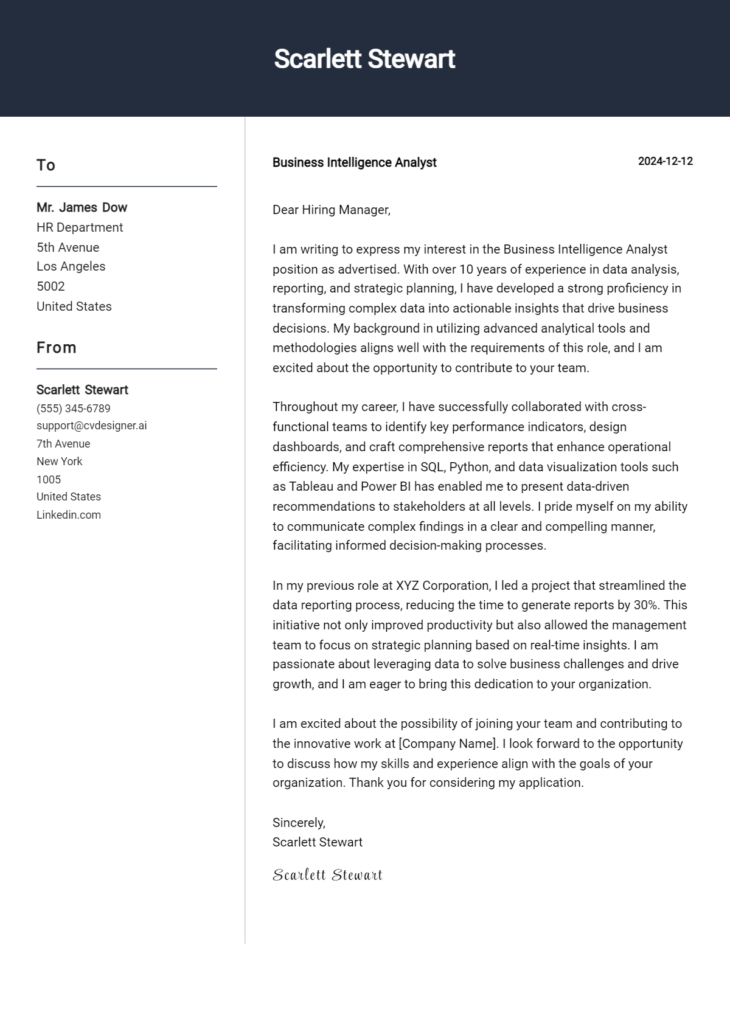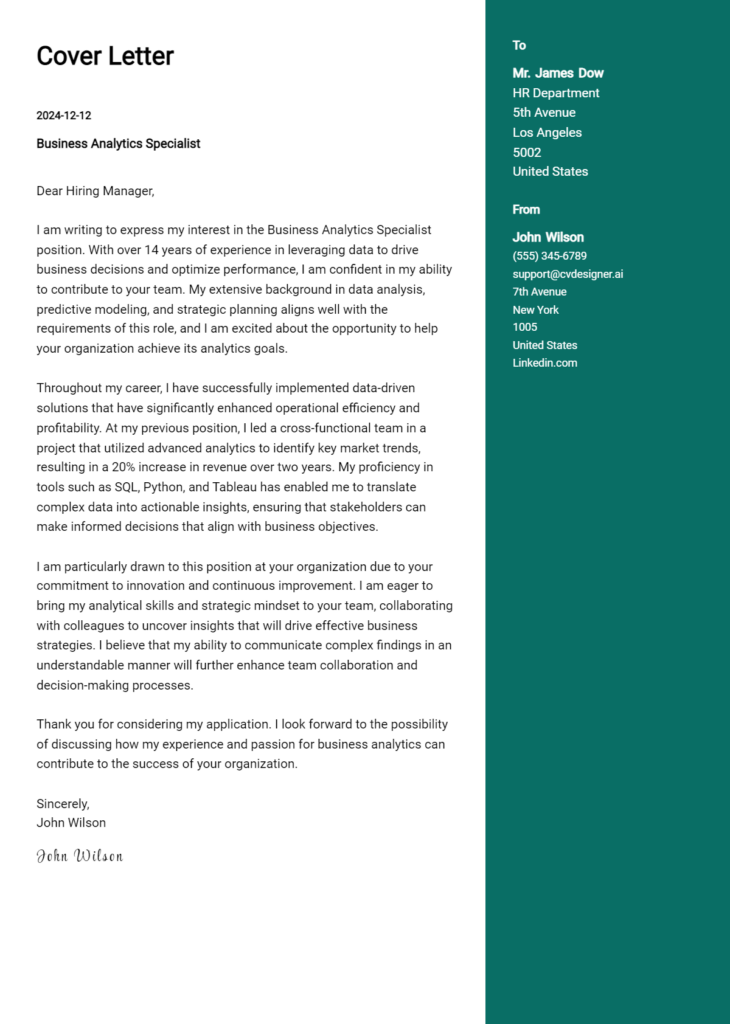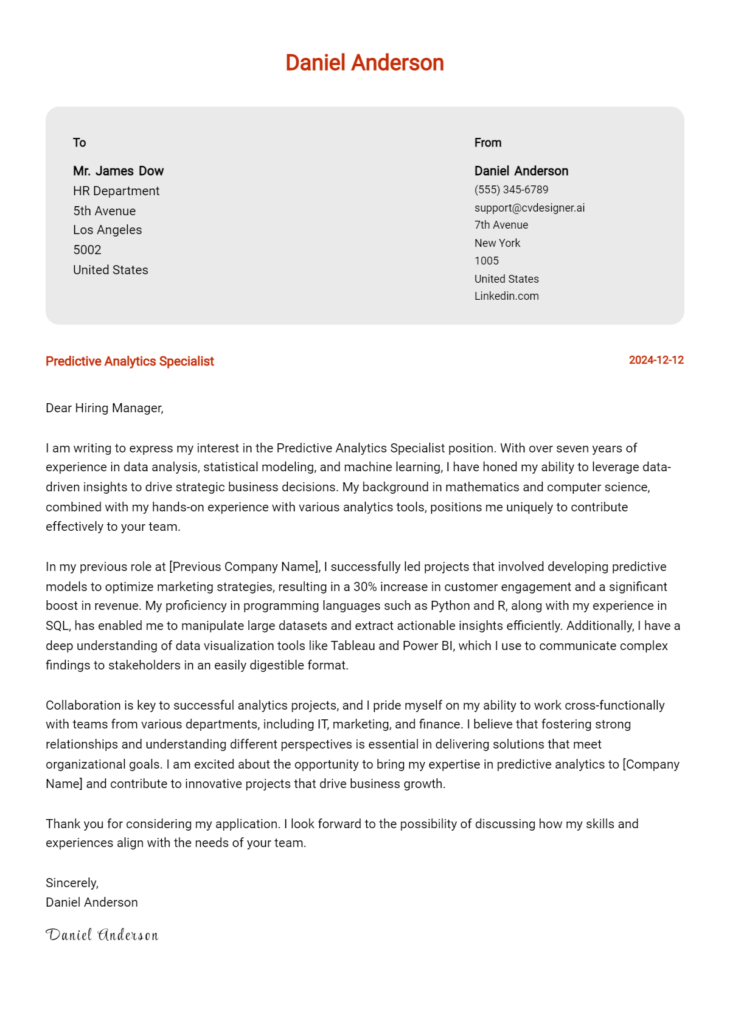Big Data Analyst Cover Letter Examples
Explore additional Big Data Analyst cover letter samples and guides and see what works for your level of experience or role.
sNz8V2OAXAXW6hmiFZTh
How to Format a Big Data Analyst Cover Letter?
Crafting a compelling cover letter is essential for a Big Data Analyst, as it serves as your first opportunity to convey not just your qualifications but also your analytical capabilities and attention to detail. The way you structure your cover letter can significantly influence the hiring manager’s perception of your skills; a well-organized and formatted letter reflects your ability to handle complex data sets and present findings clearly.
In this guide, we will discuss the critical components of a professional cover letter tailored for a Big Data Analyst position, including:
- Cover Letter Header
- Cover Letter Greeting
- Cover Letter Introduction
- Cover Letter Body
- Cover Letter Closing
Each section is pivotal in showcasing your qualifications and professionalism. Let’s delve into each part to ensure your cover letter captures the attention it deserves.
Importance of the Cover Letter Header for a Big Data Analyst
The header of a cover letter is crucial as it sets the tone for the entire document and provides essential information at a glance. For a Big Data Analyst, clarity and professionalism in the header are vital, as they reflect the candidate's attention to detail and organizational skills—qualities that are highly valued in the data-driven field. The header should include the candidate's contact information, the date of writing, and the recipient's details, ensuring that the letter is easy to read and navigate. A well-formatted header not only enhances the overall presentation of the cover letter but also ensures that the reader can quickly identify who the letter is from and when it was sent.
Strong Example
John Doe 123 Data Lane Analytics City, CA 90001 (123) 456-7890 johndoe@email.com October 1, 2023 Jane Smith Hiring Manager Data Solutions Inc. 456 Business Rd. Tech Town, CA 90002
Weak Example
johndoe@email.com October 1, 2023 Data Solutions Inc. 456 Business Rd.
The Importance of a Cover Letter Greeting for a Big Data Analyst
The greeting of your cover letter is crucial in setting the tone for the rest of your application. A well-crafted greeting not only demonstrates professionalism but also personalizes your communication by addressing the hiring manager directly. This attention to detail can help you make a strong first impression, showing that you are genuinely interested in the position and have taken the time to research the company. To avoid generic greetings that may come across as insincere, it’s advisable to look for the hiring manager’s name, which can often be found on the company’s website or LinkedIn. In cases where the name is not available, using a specific title can still convey respect and professionalism.
Strong Greeting Example
Dear Ms. Johnson,
Weak Greeting Example
To Whom It May Concern,
The Importance of a Well-Crafted Cover Letter Introduction for a Big Data Analyst
A well-crafted cover letter introduction is crucial for a Big Data Analyst, as it serves as the first impression for the hiring manager. This initial paragraph should not only capture attention but also convey the candidate's enthusiasm for the role and highlight relevant skills or achievements that align with the job requirements. A strong introduction sets the tone for the rest of the cover letter and can significantly influence the hiring manager's perception of the applicant. Below are examples of both strong and weak cover letter introductions for a Big Data Analyst position.
Strong Example
Dear [Hiring Manager's Name], As a passionate Big Data Analyst with over five years of experience in transforming complex data into actionable insights, I was thrilled to see the opening at [Company Name]. My proven track record in leveraging advanced analytics tools and methodologies to drive business growth aligns perfectly with your team's goals, and I am eager to contribute my skills in data mining, statistical analysis, and predictive modeling to help [Company Name] achieve its objectives.
Weak Example
To Whom It May Concern, I am writing to apply for the Big Data Analyst position. I have some experience with data analysis and think I would be a good fit for your company. I hope to be considered for this role.
Purpose of the Cover Letter Body for a Big Data Analyst
The body of a cover letter for a Big Data Analyst is crucial in demonstrating the candidate's technical expertise and relevant work experience to potential employers. This section should effectively showcase the candidate's skills in data analysis, statistical modeling, and database management, while also highlighting specific projects or accomplishments that illustrate their capability to contribute value to the organization. By detailing achievements such as successfully implementing a data-driven strategy that improved business outcomes or utilizing advanced analytics to derive insights from large datasets, the candidate can distinguish themselves from other applicants. A well-crafted cover letter body can significantly enhance the chances of securing an interview by clearly articulating the candidate's fit for the role and the unique value they bring.
Strong Example
As a Big Data Analyst with over five years of experience in the field, I successfully led a project that leveraged machine learning algorithms to predict customer behavior, resulting in a 20% increase in customer retention for my previous employer. By utilizing tools such as Hadoop and Spark, I was able to analyze vast datasets, uncovering key trends that informed strategic marketing decisions. My collaborative work with cross-functional teams not only improved data accessibility but also fostered a data-driven culture within the organization. I am eager to bring this expertise to your team and contribute to innovative data solutions that drive business success.
Weak Example
I have worked with data for a few years and have some experience with analysis. In my last job, I looked at data and tried to make it better. I think I can help your company with data things because I have some skills. I hope to get the chance to work with you.
Importance of Cover Letter Closing for a Big Data Analyst
The closing paragraph of a cover letter is crucial for leaving a lasting impression on potential employers. It serves as a summary of your qualifications, reiterates your enthusiasm for the role, and encourages the hiring manager to take the next step, whether that be reviewing your resume or scheduling an interview. A strong closing can reinforce your fit for the position and demonstrate your proactive nature, while a weak closing may leave the reader uncertain about your interest or qualifications.
Strong Example
Thank you for considering my application for the Big Data Analyst position at [Company Name]. With my extensive experience in data analysis and proficiency in tools like Hadoop and SQL, I am excited about the opportunity to contribute to your team. I am eager to discuss how my skills and insights can align with [Company Name]'s goals. I look forward to the possibility of an interview and am happy to provide any further information needed.
Weak Example
I hope you look at my resume. I really want this job, so please call me if you think I’m a good fit. Thanks for your time.
These tips will help candidates craft an effective cover letter for a Big Data Analyst position. A well-written cover letter is not just a formality; it’s an opportunity to showcase your technical skills, problem-solving abilities, knowledge of the Software Development Life Cycle (SDLC), teamwork experience, and a passion for continuous learning. By emphasizing these qualities, you can position yourself as a strong candidate in a competitive field.
Tips for Writing an Effective Cover Letter for a Big Data Analyst
Highlight Your Technical Skills
Clearly outline your proficiency in relevant programming languages (such as Python, R, or SQL) and data analysis tools (like Hadoop, Spark, or Tableau). Mention specific projects where you utilized these skills to demonstrate your capability. Providing quantifiable results can further strengthen your claims.Demonstrate Problem-Solving Abilities
Employers look for candidates who can tackle complex data-related challenges. Share examples of how you approached and solved specific problems in past roles. Discuss the methodologies you employed, the tools you used, and the outcomes of your efforts. This showcases your analytical mindset and practical application of your skills.Showcase Your SDLC Knowledge
Understanding the Software Development Life Cycle is crucial for a Big Data Analyst. Highlight your experience with different phases of SDLC, from requirements gathering to deployment and maintenance. Mention any collaborative work you’ve done with software developers or project managers, as this illustrates your ability to work effectively within a team.Emphasize Teamwork and Collaboration
Big Data projects often require cross-functional teamwork. Provide examples of successful collaborations you’ve been a part of, detailing your role and contributions. This could include working with data engineers, business analysts, or other stakeholders to achieve common goals, showcasing your interpersonal skills and ability to thrive in a team environment.Express a Passion for Continuous Learning
The field of data analytics is always evolving, and employers value candidates who are committed to continuous improvement. Mention any recent certifications, courses, or conferences you’ve attended to keep your skills current. This shows your dedication to staying updated with industry trends, which can be a significant asset to potential employers.
By following these tips, you can create a compelling cover letter that highlights your qualifications for a Big Data Analyst position. For additional assistance, consider using cover letter templates or a cover letter builder to streamline the writing process.
Common Mistakes to Avoid in a Big Data Analyst Cover Letter
Avoiding common mistakes in your cover letter is crucial for making a strong impression on potential employers, especially in the competitive field of Big Data. Here are some frequent pitfalls and tips on how to steer clear of them:
Generic Content: Failing to customize your cover letter can make you seem uninterested. Always tailor your letter to the specific job and company. Research the company’s projects and mention relevant details.
Overly Technical Language: While it’s important to demonstrate your expertise, using jargon can alienate readers. Strive for a balance between showcasing your skills and being accessible; explain technical terms briefly.
Ignoring Formatting: A poorly formatted cover letter can detract from your message. Adhere to a clean and professional cover letter format, ensuring easy readability and a polished appearance.
Rehashing Your Resume: Your cover letter should complement your resume, not repeat it. Use this opportunity to elaborate on your most relevant experiences and how they align with the job requirements.
Neglecting Proofreading: Typos and grammatical errors can undermine your credibility. Always proofread your letter multiple times and consider asking someone else to review it as well.
Missing a Call to Action: Not including a clear call to action can leave your letter feeling incomplete. End with a strong statement expressing your eagerness for an interview and how you can contribute to the team.
Lack of Enthusiasm: A lack of enthusiasm can make your application feel flat. Use a positive tone and convey your passion for both the role and the field of data analysis.
By avoiding these common mistakes, you can create a compelling cover letter that stands out. For inspiration, check out some cover letter examples to see how successful candidates effectively present their qualifications.
Cover Letter FAQs for Big Data Analyst
What should I include in my cover letter for a Big Data Analyst position?
In your cover letter, include your contact information, the date, and the employer's details at the top. Start with a strong opening statement that captures the hiring manager's attention. Highlight relevant skills and experiences, such as proficiency in data analysis tools (like SQL, Python, R), experience with big data technologies (like Hadoop, Spark), and any relevant projects or accomplishments. Discuss your understanding of the company’s data challenges and how your background aligns with their needs. Finally, express enthusiasm for the role and conclude with a professional closing statement, inviting them to review your resume.
How can I showcase my technical skills in a cover letter?
To effectively showcase your technical skills in a cover letter, provide specific examples of how you have applied these skills in previous roles. For instance, mention a project where you used data mining techniques to derive insights, or how you leveraged machine learning algorithms to improve business outcomes. Use quantitative results to emphasize your impact, such as “increased data processing efficiency by 30% using Spark.” Clearly connecting your technical expertise to real-world applications demonstrates your capability and makes your cover letter stand out.
Should I tailor my cover letter for each job application?
Absolutely! Tailoring your cover letter for each job application is crucial. A generic cover letter may not resonate with hiring managers looking for specific skills that match their job description. Carefully read the job posting and identify key responsibilities and required skills. Reflect these in your cover letter by highlighting relevant experiences or projects that directly relate to what the employer is seeking. This demonstrates not only your qualifications but also your genuine interest in the position and the effort you put into your application.
How long should my cover letter be for a Big Data Analyst position?
Your cover letter should ideally be one page long, consisting of three to four paragraphs. Aim for around 250-400 words. This length allows you to provide a concise overview of your qualifications without overwhelming the reader. Focus on clarity and impact; each sentence should add value. Use the first paragraph to introduce yourself and state the position you’re applying for. The following paragraphs should detail your relevant skills and experiences, and the last paragraph should express your enthusiasm for the role and how you hope to contribute to the company.
Build your Cover Letter in minutes
Use an AI-powered cover letter builder and have your letter done in 5 minutes. Just select your template and our software will guide you through the process.

